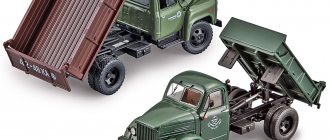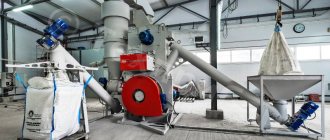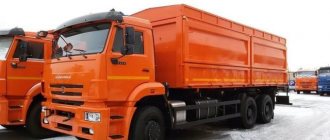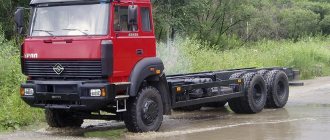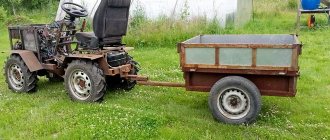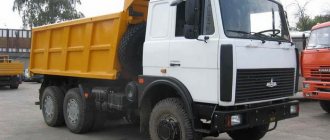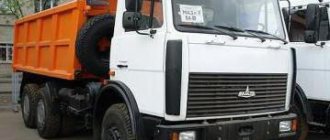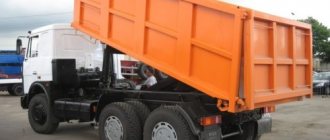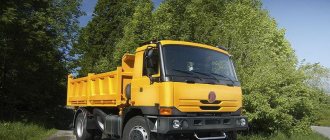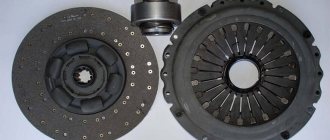| Manufacturer: | Minsk Automobile Plant (Belarus) |
| Model: | MAZ-6514A8 |
Andrey Filippov, photo by the author
Another construction project. The road made of concrete slabs allows you to cross most of the construction site without the risk of getting stuck. It’s just that the entrance to it is steep and gets steeper with each trip, and the spring mess under the rear wheels gets thinner. That’s why MAZs and KAMAZs are jumping onto the concrete road at an ever-increasing speed, risking slipping off the slabs or tearing off some unit. And only the old Tatra 815 slowly rolls up to the slab and, clinging to the hard concrete with its front wheels, easily crawls out of the liquid clay. All-wheel drive - nothing to add.
Newbie
The car in question was first mentioned by our Max Shelepenkov six months ago (see “GP” No. 9, 2009). After testing, we were able to take her for a test.
MAZ-6514A8 is a dump truck with rear unloading, not intended for operation as part of a road train. This is for those who, with or without reason, strive to attach a trailer to any truck. But its main feature is the 6x6 wheel arrangement and the dual-pitch tires of the rear bogie. By default, the car is rear-wheel drive, and the front-wheel drive is forced. There are inter-axle and inter-wheel locks at the rear, and there is also the possibility of evenly distributing power between the axles. Packed machine.
Everything is in order and with geometric cross-country ability. To the bottom rigidly fixed step - 620 mm, and to the rear beam - 490 mm. Even the bends of the MAZ platform are not scary. The lowest point is the transfer case, which is located 493 mm from the ground. The fuel tank is 640 mm, and the receivers are already 670 mm. But even these elements are difficult to reach, since the first thing the dump truck “sits” on is the underrun bars. The only weak point is the plastic bumper, made in one piece. Apparently, during operation, its place will very quickly be taken by a metal analogue from the previous generation.
The linkers did a good job. On the left side of the car, where the roadway usually is, there is only a battery with a ground button, pneumatic reservoirs and a control lever for the flow of exhaust gases. The driver uses the first ones in the parking lot before leaving and in the evening, and the second ones usually also after the shift to drain condensate. There’s no need to even talk about heating the body - on the highway, no one will reach the lever.
But on the right is everything that may be needed during operation: fuel and hydraulic tanks, as well as an autonomous heater tank. There is also a staircase to the body, and most importantly, a spare tire, which is less than average pleasure to remove while standing on the roadway.
I can't help but say a few kind words about the body. In one of my previous publications, I complained about the ineffective staircase. Forget it. Not only can you now use the stairs without fear of falling off, but there is also an additional folding ladder. It can be attached to the main one, making it easier to climb into the body, and used as a stepladder for more convenient vehicle maintenance. In the transport position, it is mounted under the body in a place where dirt practically does not get in. A useful option, but it is important that no one covets it during an overnight stay.
It has also become easier to roll up the awning on the MAZ-6514A8 - in large bodies it is wound on a reel. One cannot but rejoice at the heating of the body. MAZ testers said that they were a little doubtful whether they would be able to unload the body after the end of the tests - after all, the sand lay in the body without moving all winter, and they did not turn on the heating. But, after working for a day with the exhaust through the platform, in the evening we were able to admire how, after unloading, steam rose from the poured sand.
Among the "jambs" it is worth noting the impossibility of locking the side in the closed position when the platform is raised - you have to use improvised means, which is not always convenient.
The most inconspicuous part of the all-wheel drive was the cabin. And all because in the material about MAZ-5550V2 and MAZ-5550V3, 2010) almost everything is said about it. It is only worth noting that the ventilation and heating control unit here is electronic and keys for connecting locks have been added. For those who are especially attentive, I’ll clarify that the fluorescent lamp a la Ikarus is an initiative of the testers, with it the cabin is much lighter. We also checked the quality of the coating on the motor casing. A pleasant surprise was that a 5-liter bucket full of tools doesn’t even try to fall on the glass when the cabin is fully tilted. By the way, to raise it, you need to make 100 swings with the mount, and to lower it - only 67.
Nicknamed “Fantomas”: the history of the MAZ-6317 all-terrain vehicle
In the history of trucks of the Minsk Automobile Plant, it is difficult to find a more mysterious model than the MAZ-6317 (6x6). Developed in the late 80s on instructions from the USSR Ministry of Defense, it entered production in 1993 in the independent Republic of Belarus.
Alexander Trokhachev
The Minsk Automobile Plant received technical conditions for the creation of a three-axle truck with single tires on all wheels and all-wheel drive from the USSR Ministry of Defense back in the years of Gorbachev’s Perestroika. The Belarusian “laptezhnik” was supposed to become a kind of analogue of the KrAZ and replenish the fleets of motor battalions in all military districts. The prototypes managed to pass not only factory running tests, but also acceptance tests in the vast expanses of the Soviet Union. The car tore through the virgin snow of the Far North and withstood the bitter frosts of Siberia, confidently kneaded the mud and marshy areas of central Russia, and did not succumb to the sands and heat of Central Asia. In a word, according to the creators' idea, he was supposed to become a universal soldier.
The prototype MAZ-6317 (6x6) 1991 had rectangular headlights.
Once during testing, one of the drivers, looking at the prototype that had been scratched to the top of the cabin, said to his colleagues: “Well, what a scare! Just a military threat! Not a truck, but a Fantomas!” Since then, this unspoken nickname has stuck to the all-wheel drive. And it can be considered successful: it took root!
Based on the results of all inspections and tests, the MAZ-6317 (6x6) was recommended for adoption. According to the approved plan, this was supposed to take place in 1991. However, in January-April 1991, a monetary reform took place to exchange 50- and 100-ruble bills of 1961 for banknotes of a new type, and in December the Soviet Union de jure ceased to exist. The Armed Forces of the newly formed Republic of Belarus did not require such a vehicle in large quantities, and even in the early 90s, Soviet-made equipment was sufficient. Figuratively speaking, the serial production of the MAZ-6317 was paused.
Four years after the collapse of the USSR, the Minsk unique product was remembered thanks to successful tests of a potential customer from Africa. I thought: why not position the MAZ-6317 as a dual-purpose vehicle?! No sooner said than done: the Fantomas began to be offered as a civilian all-terrain vehicle, not only in the CIS, but also in foreign countries. And then the Belarusian military took a liking to him. Love at second sight happened due to the fact that the Soviet Urals, KamAZs and KrAZs were already demanding write-off.
Beginning in 1996, Minsk car manufacturers went to Bronnitsy near Moscow for several years in a row to the NII-21 training ground. Here, on a special track, they took part in the Russian Open Truck Trial Cup. Drivers from the road testing department and MAZ mechanics gained experience and knowledge to improve the all-wheel drive all-terrain vehicle. In 1997, Fantomas took part in the Master Rally on the route from Baikonur to Moscow. Minsk trucks were also used as fuel tankers and tow trucks. As part of the competition, Belarusian athletes were awarded a special prize from the organizers “For courage and mutual assistance.”
One of the spectacular moments of the MAZ-6317 “swim”.
The sporting experience turned out to be so successful that, on a wave of euphoria, Minsk residents almost decided to take part in the Paris-Dakar rally marathon. But then they weighed everything and, as an alternative, focused their interest on the truck trial. At the origins of the project were the director of the Minsk Auto dealership, Andrei Biryukov, and the head of the MAZ circuit racing team, Alexander Sinkevich. In February 1999, two crews on a MAZ-6317 went to Bronnitsy for the Russian Open Truck Trial Cup. They included test drivers Pyotr Orsik and Sergei Kruk along with co-drivers Yuri Dzhanashiya and Dmitry Kniga. And in May 1999, the joint MAZ-Yarovit team was created, which became known far beyond the borders of the Republic of Belarus.
Already at the beginning of June of the same year, enthusiasts went to the first stage of the Eurotrial in the Austrian city of Mieders, but they failed to conquer Europe right away. But the potential of the practically serial MAZ-6317 was revealed in the fall of 1999 at the First Belarusian Open Truck Trial Cup. Experienced racer Viktor Moskovskikh was invited to join one of the three crews on the MAZ-6317. In their category, the Belarusian crews Sergei Kruk - Dmitry Zaporoshchenko and Viktor Moskovskikh - Yuri Dzhanashiya took silver and bronze, leaving behind only one Russian crew of Vasily Kudryaev - Andrey Afanasyev on the Ural-4320.
The car of the Belarusian team at the Master Rally
The popularity of the MAZ-6317 increased sharply after its demonstration at the Russian Expo Arms 2000 exhibition in Nizhny Tagil. On a specially prepared track, the Belarusian truck overcame all obstacles, including ditches, scarps, and a deep ford. “Fantômas” also behaved confidently in the section of the tank training ground, where it went either by mistake or deliberately: to illustrate its amazing maneuverability. It’s a pity, but the paths of Yarovit CJSC and the Minsk Automobile Plant diverged over time, and since 2001, truck trial competitions are no longer held in the fraternal state. However, this did not affect the fate of the MAZ-6317.
MAZ-6317 chassis at a truck trial in the Leninskoye quarry in the Minsk region.
A powerful steel frame, the ability to mount a cargo platform 6250 mm long, a high-torque 330-horsepower YaMZ-238D V8 engine for civilian versions and a 425-horsepower TMZ-8424 from the Tutaevsky Motor Plant for the military, wide 16.00 R20 tires and a high ground clearance of 350 mm served the vehicle well. good service. Another aspect that has become attractive is the power reserve. With two fuel tanks of 200 and 350 liters, it reaches 1200 km. Both the army and civilian versions don’t need more. The car's carrying capacity is also decent: 11,000 kg. As standard, the MAZ-6317 is equipped with a 100 kN winch with a coupling device output on a 60-meter cable to the rear, and upon request, a second winch can be installed at the front. It can work both manually and automatically.
By the way, Fantomas has several modifications. For example, MAZ-6317-021 and MAZ-63172 with a TMZ-8421 engine from the Tutaevsky Motor Plant with a capacity of 360 hp. With. Some of the vehicles are equipped with power units from the Yaroslavl Motor Plant YaMZ-7511 with a potential of 400 hp. With. and YaMZ-6585 with a return of 420 hp. With. All this allows the customer to choose the most suitable configuration option in accordance with the nature of the transport tasks being solved. But there is no alternative gearbox: 9-speed manual YaMZ-239. The power line also uses a single-stage transfer case with a reduction gear. Only the front axle differential remains without locking, but consumers are happy with this.
The powerful chassis, coupled with “chubby” tires, provides the truck with almost tank-like cross-country ability.
It is not surprising that a wide range of weapons systems and civilian special superstructures began to be installed on the rugged MAZ-6317 chassis. Military vehicles can be seen at the parade in the Hero City of Minsk, and civilian vehicles can be seen at specialized exhibitions in Moscow and Russian regions. One of the most famous examples in camouflage or the usual matte khaki is “BelGrad” (from “Belorussky Grad”), a BM-21A “Grad” multiple launch rocket system on a MAZ-6317 chassis.
August 1994.
MAZ-6317 at a parade of vehicles in the Belarusian capital in honor of the 50th anniversary of the Minsk Automobile Plant. Tests of a prototype from JSC 2566 Radio-electronic Weapons Repair Plant took place almost a quarter of a century ago, in December 1997. Among the civilian workers based on the MAZ-63172 (MAZ-631708, MAZ-631710) with dual tires on the rear wheels are shift buses, technical vehicles, tow trucks, truck cranes, timber trucks, dump trucks, drilling rigs and other special equipment.
Car lift AGP-40K on a MAZ-6317X9 (6x6) chassis with a YaMZ-65853 Euro-4 engine with a power of 330 hp.
With. The MAZ-63171 with an increased body length with a volume of up to 33 m3 has also become widespread. The Fantômas family also includes a lightweight two-axle version of the MAZ-5316 (4x4) with a lifting capacity of up to 6000 kg, although it deserves a separate story. The closest relatives of the hero of the story in civilian form are the MAZ-6425 (6x6) truck tractor and the MAZ-6517 (6x6) dump truck.
Fire tanker truck of the Belarusian fire chiefs on the MAZ-63171 (6x6) chassis.
Collectors of stand replicas of cars also did not remain indifferent to the MAZ-6317. For example, in scales 1:87 and 1:43 “Fantomas” is made of resin, in M 1:35 from plastic, and in proportions 1:32 and 1:25 from paper. All connoisseurs of miniature trucks are looking forward to domestic manufacturers delighting collectors with industrial metal models. There is a demand for such products not only in Russia.
Even in paper, handmade masters are able to convey the detail of components and assemblies.
Interesting fact: at the XII International Exhibition “Zbroya and Bezpeka” on September 22-25, 2015 in Kyiv, the intention to establish a licensed assembly of the MAZ-6317 at production facilities in Cherkassy was announced. Together with this model, it was planned to produce the army MAZ-5316 (4x4) and the MAZ-6425 (6x6) truck tractor from Belarusian vehicle kits. Naturally, there was no question of any bison emblem: the trucks were named “Bogdan-6317”, “Bogdan-6315”, “Bogdan-6425”. At the start of the project in 2016, 120 vehicle kits were purchased. To be fair, it must be said that the Ukrainians dismantled the cabin from the MAZ-6317 chassis and in its place they installed their own armored cabin with Stanag 1 protection level. The NPO Praktika kung, made of Finnish or Swedish-made armor plates with an airborne compartment for 23 soldiers, was rigidly fixed on the frame.
Thus, the story of an essentially Soviet truck from the 20th century continues successfully into the 21st century. And as long as there is commercial demand for such equipment, the MAZ-6317 with the informal nickname “Fantomas” will remain in service.
The editors recommend:
Why do piston rings stick and how to prevent it?
A traffic police officer searched my car: did he have the right to do so?
Russians may be left without foreign cars: Western automakers have stopped supplying cars to our country
A ship that was transporting cars to Russia was detained in France
Half of the car factories in Russia have closed
- truck
- Maz
News Media2
Discussion Cancel
1 comment
- Sergey:
02/17/2022 at 04:52
Good technique. Well done Belarusians.
Answer
Whatever is done...
Now we have come to the main and only tricky part of our test drive.
Initially, we planned to test this interesting car fully loaded, measuring fuel consumption, acceleration, etc. We were very upset when they failed for technical reasons. But the bitterness from this failure instantly went away as soon as we tried to drive an empty dump truck along the roads of the Dmitrovsky training ground: after all, if we had carried out our plans, the fuel consumption figures would have turned out to be very “fun”.
The fact is that I have never seen such a “tight” engine. The Yaroslavl G8 categorically did not want to move MAZ in space. The dump truck didn’t even want to move out of the highest, fifth gear of the lower row, and when I tried to do this in sixth, it simply stalled. Acceleration was carried out slowly and stopped... Although no - it came to naught at 80 km/h. When driving on the roads, I had to constantly move the lever, changing gears, as soon as there was any sign of a rise, or brake.
The only way out of this situation was to move in “gas to the floor” mode, without looking at the holes and without braking in turns. As a result, I very quickly began to praise those who worked on the suspension and steering of the MAZ. The empty dump truck was going exactly where it needed to go. No yaws on potholes, no drift in turns. I’m generally silent about the lack of shaking in the cabin. Even sitting on the engine casing, and not on the passenger seat, I did not feel any discomfort, let alone the driver's sprung seat. I became so impudent that at the end of the trip I stopped slowing down even on a small ramp, and MAZ took everything for granted, without even trying to buck or bother me with the rumble of the body or the creaking of panels.
I understand that the car came to test handling, not acceleration dynamics, but I still felt sorry for the testers who had covered 39,000 km with a full load along various roads of the test site. According to them, driving in I–III gears was the norm for them. I would like to hope that this is just a single unsuccessful engine that ended up on the dump truck being tested. After all, the striking contrast between a good chassis and a stupid engine is clearly not in favor of the Yaroslavl engine builders.
The cooler the SUV...
We did not plan to do off-road rides, despite the fact that our ward has all-wheel drive. The fact is that the road tires on the MAZ wore out during the tests and it would be incorrect to drive into the fields on them. No, of course, to clear our conscience we rode on 15-centimeter virgin soil. But, firstly, for a true construction dump truck this is not an obstacle, and secondly, with rear-wheel drive and without a load, the MAZ quickly rested on the melted snow and began to “dig in”, and after connecting the front end, on the contrary, it simply ignored the crust. However…
Off-road came from where we didn't expect it. For the sake of a beautiful shot, I asked to park the dump truck at the side of the road, which turned out to be much closer than we expected. Turning around, the MAZ bumped its bumper into an innocent-looking snowdrift, and when we connected the inter-wheel locks and tried to move over it, due to a slight slope it slid half a meter to the right and “one or two times” dug itself a magnificent hole. Connecting the front axle and center locks did not give anything - the car sat firmly, and the presence of snow under the wheels did not allow it to catch on solid ground. We decided to simply melt the ice and get to the ground. After half a minute of “grinding,” the earth flew out from under the wheels on the left, but by this time the starboard side had finished digging in and the dump truck showed with all its appearance that it would not go any further.
I had to split up - my colleagues went to get the tractor, and I started excavating. The arrival of the Ural showed us the naivety of our attempts to leave on our own. Having cut in three of his bridges, he slightly sanded the asphalt covered with compacted snow, after which the cable was torn. It’s good that the second Ural, called to help, was able to stand on clean asphalt, and only after that, having turned on everything possible on all three cars, we pulled the MAZ onto the road.
I can also state that, despite the dirt flying from under the wheels, both the body and the rear lights remained clean. This means that, despite the apparent simplicity and primitiveness, the protective covers for the rear wheels do a good job of their duties.
During testing in the sands of Turkmenistan
0
Source:
From November to December 1988, five cars, three MAZ-6317 and two MAZ-6425, were tested. During them, the cars covered 49 thousand km. The trucks traveled under their own power from Minsk to Surgut, Ashgabat, highland Osh and back. The results revealed insufficient reliability of the vehicles. The average time between failures did not exceed 4.1 thousand km, instead of the 10 thousand required by the customer. The time between engine failures was 22.5 thousand km. Some cars had frames cracking, spring ladders and power unit supports were destroyed. Nevertheless, the industry commission recommended that the trucks be put into production, subject to the elimination of the identified deficiencies. What the plant actually did.
0
Source:
6x6=???
I suppose you have a question: “So who needs a dump truck with three drive axles and a dual-pitch tire, if it even gets stuck in the snow?!” That's the point: in the snow, and on worn tires with a road tread pattern. If the MAZ-6514A8 tires had been more toothy, he would have left the trap before he had time to dig holes for himself. To check, we went to a quarry that had partially thawed from the snow. And everything there was exactly as we expected. On rolled wet snow, we had to overcome even a small slope on foot, but MAZ took a much steeper climb, but covered with clay, effortlessly, without using even half of its off-road arsenal. We even stopped on purpose on the hill, and then calmly drove on.
So, when building a zero-cycle or developing a quarry, take a closer look at this vehicle; its body is designed to withstand both strong shock loads and the transportation of large volumes of cargo, and the off-road potential of the chassis is quite large. In addition, a dual-pitch tire will allow, if necessary, with one deflated cylinder to get out to a more or less dry area, and not to plunge into a puddle to install a jack in order to change a hefty “bast shoe”. The main thing is to carefully monitor the tread wear, and then this all-wheel drive will become a universal lifesaver in choosing between road MAZs and KAMAZs and definitely off-road mastodons from Kremenchug...
Provided a car for testing
Technical characteristics of the MAZ-6514A8 (6x6) car
| Total weight, kg | 41 900 |
| Curb weight, kg | 15 620 |
| Load capacity, kg | 26 200 |
| Distribution of total mass along the axes, t | 9,9/ 16,0/ 16,0 |
Engine:
| YaMZ-6581.10 Euro 3 or YaMZ-6581.4, turbodiesel, V8 14,861,399.7 at 1900 min-1 1766 at 1100–1300 min-1 |
Transmission:
| YaMZ-239, mechanical 9/ 1 |
| Clutch | YaMZ-184 |
| Front suspension | Spring with shock absorbers and anti-roll bar |
| Rear suspension | Spring with stabilizer of the 3rd axis |
| Brake system | With ABS, drum brakes |
| Wheel formula | 6x6 |
| Tires front | Continental HSC 12.00R24 |
| Tires at the rear | Continental HDC 12.00R24 |
| Fuel tank capacity, l | 300 |
